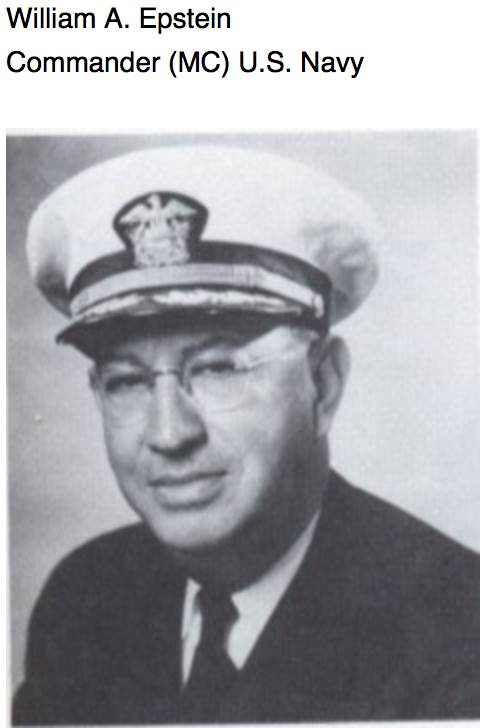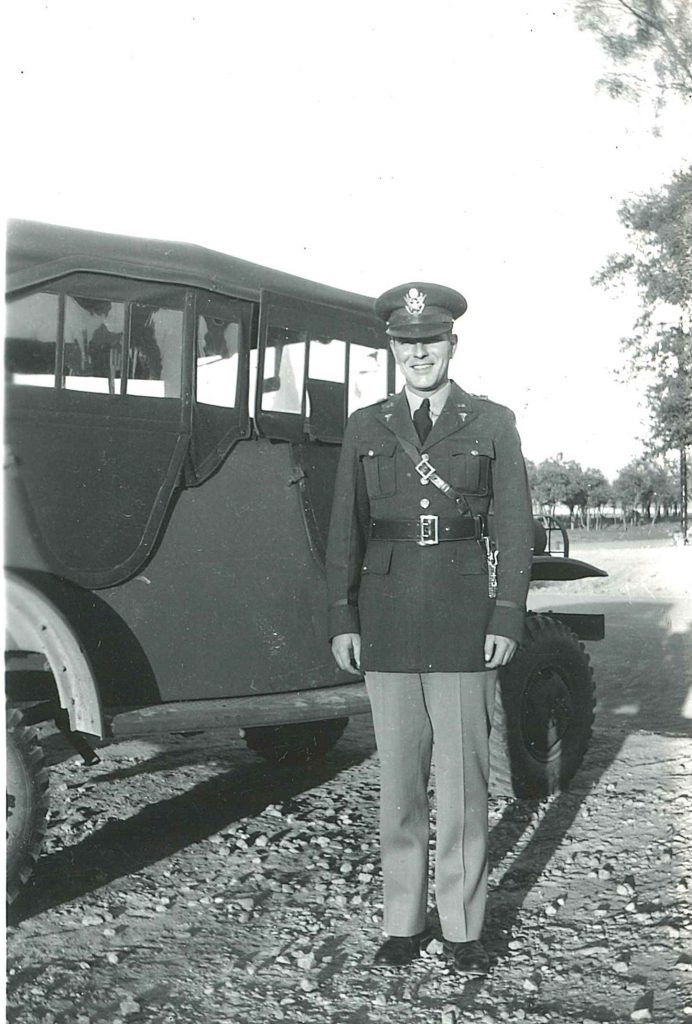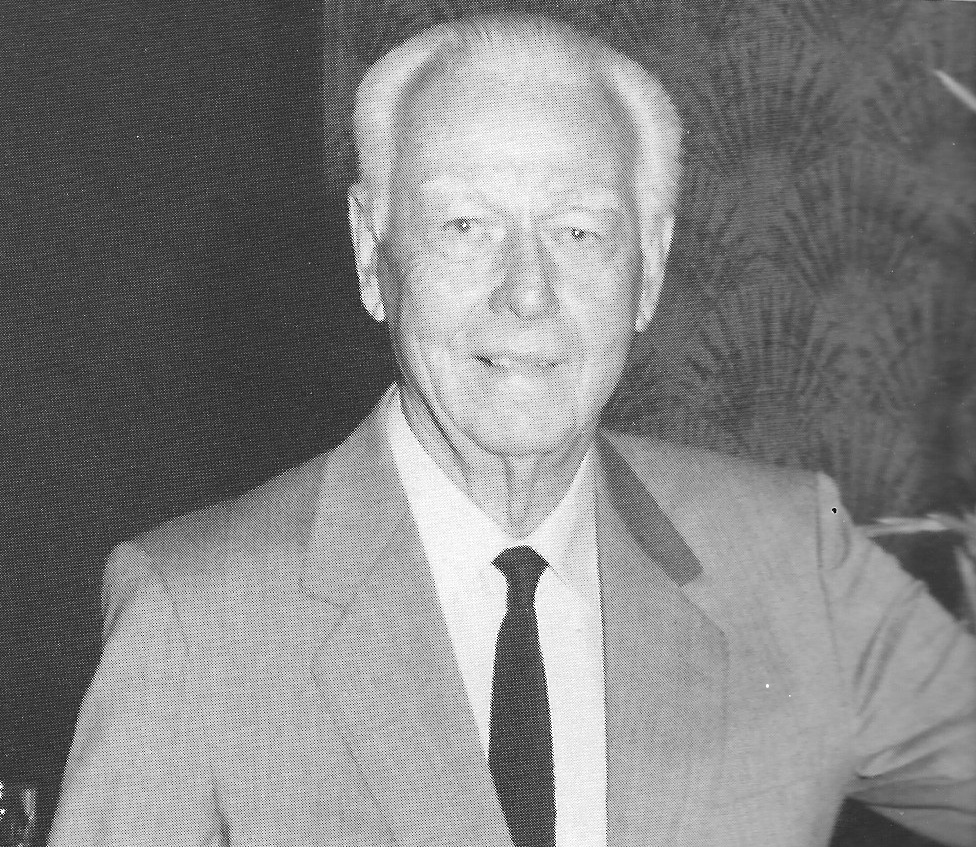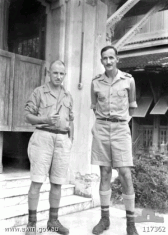US Medical Staff & Dr. Henri Hekking
As a member of the US ARMY MEDICAL DEPARTMENT (AMEDD) as both enlisted and officer, I naturally have a special interest in the medical aspects of the POW story. I have touched on the medical aspects of the POW ordeal and the causes of death in other Sections of this website.
Herein I will relate the journey of the 34 medical personnel in these units. As with any of the POW groupings, there are almost as many individual stories as there are men. Of the 34, 27 were TXNG, 1 was Regular Army and 7 were USN. The full story of PFC Harry Gray of the 1314th MED GRP is told in Section 3.8. But for purposes of this essay we will include him with the 2/131 contingent.
First, the USN personnel. Two of them were physicians: CDR William Epstein and LT Clement Burroughs. The others were Pharmacist’s Mates. Burroughs and two of the PMs (PM2c Eugene Orth & Lowell Swart) were left at the Bicycle Camp when the others departed and were liberated from there. CDR Epstein and the other three PMs were part of the Tharp Party. Pharmacist’s Mate 3rd class Dale Cooper died of complications of Tropical Ulcer in SEP 43 at the 100 Kilo Camp. Pharmacist’s Mate 2nd class Alois Kopp was trans-shipped to Saigon after THR completion. Dr. Epstein and PM2c Raymond Day stayed with the main Tharp Party throughout their captivity.
According to H. Robert Charles, in his book LAST MAN OUT, two other POWs served as medical assistants. He names them as corpsmen by other official records do not agree. These are SM2c Robert Hanley and TXNG PVT Houston “Slug” Wright. Wright is carried on the TXNG rolls as a Private in Battery F with no reference to any medical responsibilities. Similarly as a Seaman, Hanley would have had no medical function on the USS HOUSTON. It is unclear if perhaps either or both of these men had prior medical experience.
Of the 26 TXNG medical staff, two were evacuated from Java with the AAF and were not taken prisoner. However, PFC William Fraser remained with the Pacific Theater and is listed as KIA when the B-17 on which he was serving as a gunner was shot down over Rabal in Jan 1943. The post-Java military career of PFC Harold James in not well documented. He eventually retired from the USAF as a Master Sergeant.
Of the 26 TXNG medical staff POWs, 18 were part of the Tharp Party; 3 with Fitzsimmons and 3 with Zeigler. One of the Fz Party members was left in Singapore and worked the TBR in Thailand as part of F Force: PVT Herman Wilhite. Unlike the majority of the Hintok group, he was not returned to Singapore but was apparently liberated from one of the camps in Thailand. The other two members of the Fz Party (PFC Walter Guzzy and PVT Jesse Butler) were trans-shipped to Saigon.
Under similar circumstances, SSG Claude Thomas Jr was left behind in Singapore as the Zeigler ‘technicians’ Party passed through there. He was later trans-shipped to Japan and was seemingly reunited with other members of that group at the Ohashi 04B camp. There he caught up with PVT Fred Mireles. CPL Douglas Knight from that group was liberated from the Bibai Camp 01B.
The remaining 18 TXNG medical staff including CPT (Dr.) Samuel Lumpkin were assigned to the Tharp Party. Of those, 5 died while working the TBR. Two – Dr. Lumpkin and PVT Wendell Carney — died of Dysentery. The other three (PVTs James Drake, Johnny Jowell and Allard Parker) died of Tropical Ulcer. All except PVT Parker (NOV 43) died during the Speedo period.
Two others were trans-shipped to Saigon; PVTs John Labove and Oscar Webster. The 10 remaining 11 were liberated from various camps in the Kanchanaburi area with one (PFC Raymond Reed) being sent to the camp in Petchburi. Those 10 are:
| ROGERS John Edward Jr | SSG |
| NAYLOR Keith Forest “Zeke” | SGT |
| HALL GEORGE Chester | CPL |
| JONES Paul Chestnut | CPL |
| TIMS Roy Edwin | CPL |
| HARRIS Claude Rayford | PVT |
| KILPATRICK Roy Franklin | PVT |
| REDWINE James D | PVT |
| YORK Bill | PVT |
| YORK Coy Denver | PVT |
Of the 26 medical personnel who worked the TBR – two of them USN – all but three were in the Tharp Party and seven of those 23 (30%) died there. These 7 included PFC Harry Gray (non TXNG) and PharmM Dale Cooper. So the medical personnel as a sub-group of the Tharp Party suffered a somewhat higher death rate than that party as a whole. None of the three medical personnel in the Fz or Hintok groups died on the TBR.
Apparently none of the 2/131 medical personnel were left with E Battery at Surabaja. This seems illogical, so perhaps a few are simply listed as members of E Battery even though they were medical personnel.



In his book Last Man Out, H. Robert Charles, an American Marine survivor of the sinking of the USS Houston, writes in depth about a Dutch doctor, Henri Hekking, a fellow POW who probably saved the lives of many who worked on the railway. In the foreword to Charles’s book, James D. Hornfischer summarizes: “Dr. Henri Hekking was a tower of psychological and emotional strength, almost shamanic in his power to find and improvise medicines from the wild prison of the jungle”.
Dr. Henri Hekking was a Lieutenant in the Dutch Army assigned originally as an Intern at the Batavia Army Hospital. He apparently got himself caught up in a long-standing feud between the Hospital commander and the governor of the island. He was ‘exiled’ for a short period to the DEI island of Celebes. The precise circumstances of his capture are not available, but he was interned at the Bicycle Camp and eventually was assigned to the Fitzsimmons advance party and remained with them throughout their TBR time. He is said to have been the chief medical officer of the hospital in Surabaja, but this would not necessarily explain how he came to be interned at the Bicycle Camp as opposed to with the E Battery group of POWs.
Post-war, Hekking returned to the Netherlands to serve at the Amsterdam Institute of Tropical Medicine. He retired as a Major and was awarded the Military Order of William which is presented for feats of excellent bravery on the battlefield and as a meritorious decoration to senior military officers.
He maintained contact and a long-standing friendship with members of the LOST BATTALION ASSOCIATION and attended several of their reunions before his death in 1994 at the age of 91.
He is described as suffering great discomfort in his later years due to injuries to his vertebrae from beatings administered by the POW guards.
While he was a POW on the TBR, his wife and 2 children were in a civilian internment camp on the DEI island of Timor and post-war he located them on the island of Celebes. His mother was reported to have died while an internee on Java.
================
A somewhat different take on his legacy:
HACKING WHEN IT COUNTS: SURVIVING THE BURMA DEATH RAILWAY
by Dan Maloney
www.hackaday.com/2015/10/28/hacking-when-it-counts-surviving-the-burma-death-railway/
With the [Fitzsimmons party of US] POWs was Doctor Henri Hekking, who had been born and raised in the former Dutch East Indies colony of Java (now Indonesia). He had spent his early years with his grandmother, a master herbalist who served as “doctor” for the native villagers. Inspired by his oma’s skill and convinced that the cure for any endemic disease can be found in the plants in the area, Dr. Hekking returned to Java as an officer in the Dutch army after completing medical school in the Netherlands.
After his capture by the Japanese, Dr. Hekking did everything he could to help his fellow POWs despite the complete lack of medical supplies, all the while suffering from the same miserable treatment. Hekking realized early on that the starvation rations the POWs endured were the main cause of disease in the camps; a cup of boiled white rice doesn’t provide much energy for men building a railway by hand in jungle heat, and provides none of the B vitamins needed by the body.
Weakened by nutritional diseases such as beriberi and pellagra, the POWs either wasted away or became susceptible to dysentery or any of a host of tropical infections. He solved these problems with a little jungle ingenuity. To bolster the protein-poor diet, he cooked blood from a water buffalo slaughtered for the Japanese mess into the POW’s rice. To round out the diet, he recovered B vitamin-rich rice husks from an abandoned jungle village’s grindstones and made cakes that the prisoners ate. Neither were terribly palatable, but the improved nutrition made a difference.
Hacking Solutions, Not Limbs
Still, the jungle and the Japanese dealt out endless punishment, and even with improved nutrition the men were falling sick. Particularly nasty were tropical ulcers; the slightest scratch would become infected in the fetid jungle conditions, and the infection would bore into the flesh right to the bone. Refusing to accept that amputation was the only option, Doc Hekking chose instead to debride the ulcers. Lacking proper surgical instruments, he sharpened the bowl of a teaspoon and scraped dead tissue from wounds. Four men would hold down the patient; the only anesthesia was when the man finally passed out from the pain. The remaining infection was treated with Doc’s herb-lore; one trip into the jungle yielded the fruit of the pomelo tree, covered with a gray fungus that his grandmother had taught him about. A poultice of the fungus yielded a powerful topical antibiotic; years later the fungus was found to secrete a substance similar to penicillin, at the time only coming into commercial availability. By going old school, Doc Hekking was ahead of the curve.
Early on in his internment, Doc Hekking was drawn to the Americans in the camp. He thought they were crazy – laughing and joking in the face of untold misery, and willing to do whatever it took to survive, even when it meant eating his foul but nutritious concoctions. Most of the American sailors and marines in camp were farm boys who had come of age in the Depression, and were used to hardship and making do. Such skills were particularly useful in cobbling together the equipment Doc Hekking needed to help the men. When major wounds needed sutures, James “Packrat” McCone fashioned the needle from a scrounged safety pin. He hammered a flat spot and used a pocket knife to ream a hole for some twine. Boiled for a few minutes, it did the trick. When a badly ulcerated leg needed a special surgical tool to remove infected bone, a POW in another camp fashioned scrap metal into the chisel-like instrument that Doc needed to save the patient’s leg.
When Life Hands You Bamboo, Make Everything
Besides the salvaged metal from food tins and bits of detritus that formed most of Doc’s medical kit, the most common material for hacking solutions to the POWs’ problem was undoubtedly bamboo. Flexible, strong, lightweight and ubiquitous, bamboo found its way into all sorts of camp utensils. Water containers, knives and eating utensils, toothbrushes, instrument holders and dozens of other items were fashioned from bamboo, not to mention the very structures the POWs lived in and the meager furniture they had. Crutches and even prosthetic limbs were made from bamboo for the unlucky amputees in camp. One of Doc Hekking’s innovations to avoid amputation from tropical ulcers was to not dress the open wound, which he feared would result in a warm, moist environment that would hasten infection. Instead, Doc fashioned bamboo splints into a cage that was fastened over the wound, preventing anything from bumping into it and allowing it to breathe. Berated by a British doctor in the camp who wanted to amputate the leg of one patient sporting the contraption, Doc stood his ground. The patient lived.
Doc Hekking’s Legacy
Accurate estimates of the cost of the Burma Death Railway in terms of human lives are hard to come by, but it’s pretty well established that of the 60,000 or so POWs enslaved, about 20% died. That means the railway claimed about 45 lives for every mile of its 268 mile length, or one every 117 feet.
But what of Doc Hekking’s results? Did his men fare better under his unconventional treatments and hacked solutions? It seems so. While the overall POW death rate was 20%, Doc managed to keep his losses to 7% of the 194 men in his camp. And importantly, Doc performed not a single amputation.
Doc Hekking proves that sometimes, you can accomplish a lot with nothing at all, and that knowing things is often better than having stuff.
One Australian physician is mentioned by a number of the US POWs as having played a role in their survival. He is remembered mainly as the primary doc to perform amputations as a result of Tropical Ulcers. Albert (Bertie) Coates’ story is related by a grandchild at:
https://www.pows-of-japan.net/articles/37.htm

